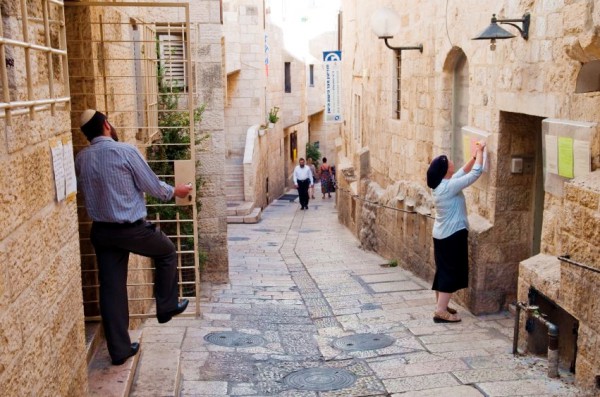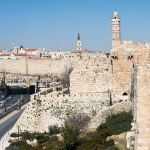“Take note of the fortified walls, and tour all the citadels, that you may describe them to future generations.” (Psalm 48:13)
Jerusalem is one of the oldest, continuously inhabited cities in the world.
It has been blockaded, burnt, looted, captured, destroyed, and mourned. It also has been prayed for, longed for, rebuilt, rejoiced over, honored, and chosen by God as the place for His name to dwell.
“For the LORD has chosen Zion, He has desired it for His dwelling.” (Psalm 132:13; see also Ezra 6:12 and Zechariah 2:12)
Because the Old City of Jerusalem is considered holy by Judaism, Christianity and Islam, this ancient city and its walls are listed as a UNESCO World Heritage site; nevertheless, the United Nations’ Heritage List deliberately fails to mention that Jerusalem is in Israel.

Although the Old City of Jerusalem lays within its walls, the city proper now extends well beyond them.
Suleiman’s Walls
“May there be peace within your walls and security within your citadels.” (Psalm 122:7)
The Old City of Jerusalem has been surrounded by walls since ancient times.
The current walls, built between 1535–1538 by the Ottoman Sultan Suleiman the Magnificent, are almost 4 kilometers (2.5 miles) in length, 12 meters (40 feet) high and 2.5 meters (8.2 feet) wide.
Though they are not especially thick, these walls have never been breached apart from an area that was opened in 1898 near the Jaffa Gate in preparation for the visit of the German Emperor Wilhelm II, as well as various gate modifications. (IAA)

This breach in the wall near Jaffa Gate was created so that in 1898 the German Emperor Wilhelm II could enter Jerusalem on a white horse, accompanied by a large entourage of people.
His advisers suggested that the dream meant that it was time that he rebuild Jerusalem’s crumbled walls.
Some scholars have suggested, however, that Suleiman fortified Jerusalem after hearing rumors of a new Crusade by the king of Spain. Still others believe they were rebuilt to protect the city from Bedouins, marauders and wild animals.
Suleiman essentially rebuilt these new walls on the remains of earlier walls, using stones taken from ancient buildings. (IAA)
Yeshua Prophesies the Destruction of Jerusalem
Yeshua (Jesus) foresaw the destruction of the walls of Jerusalem, which were destroyed by the Romans after Jerusalem fell in AD 70.
While He was on the Mount of Olives, just prior to His entrance into Jerusalem on a colt, Yeshua wept over the destruction that would come upon the city because of our rejection of Him, saying:
If you, even you, had only known on this day what would bring you peace—but now it is hidden from your eyes. The days will come upon you when your enemies will build an embankment against you and encircle you and hem you in on every side.… They will not leave one stone on another, because you did not recognize the time of God’s coming to you. (Luke 19:42–44)
He also prophesied the destruction of the Second Temple.
Yeshua left the Temple and was walking away when His disciples came up to Him to call His attention to its buildings. “Do you see all these things?” He asked. “Truly I tell you, not one stone here will be left on another; every one will be thrown down.” (Matthew 24:1–2)
His prophecies were fulfilled to the letter.
In AD 70, Titus (the son of Roman Emperor Vespasian) and three Roman legions surrounded Jerusalem, hemming in the population with a trench and a new wall that they built to equal the height of the city walls. Those caught trying to escape Jerusalem were brutally murdered.
Breaching Jerusalem’s walls, however, was no easy task.
It took Titus seven months to break through the three walls that surrounded Jerusalem in the first century.
According to Josephus, the first wall was made by David and Solomon. Not much is known about the second wall, but Josephus said it enclosed the northern quarter of the city, beginning at the Garden Gate and extending to the Antonia Fortress.

Though the walls of Jerusalem were grand, they might have seemed dwarfed beside the walls of the Temple Mount. Antonia Fortress, a military barracks built around 19 BC by Herod, is in the top right-hand corner of the Temple Mount, as seen in this model.
The third wall was built by Agrippa I, Herod the Great’s grandson, who started building it in AD 40.
He did not finish the wall, however Roman Emperor Claudius, a friend of Agrippa, ordered the work to stop after Syria’s governor had suspicions about Agrippa’s motives in building it.
Josephus describes the wall as impressive:
“If the wall had been finished,” Josephus wrote, “the city would never have been taken, for it was built of bonded stones 30 feet long and 15 broad… The wall itself was 15 feet thick, and its height would no doubt have been greater.” (Blaxton)
Although the rebels fortified it to a height of 30 feet, their hasty reinforcements did not withstand the onslaught of Titus and his legions.
Not much of this forgotten wall remains; it was only discovered in the 1930s by archaeologists who were guided by Josephus’ descriptions.
Although Vespasian had not wanted the Second Temple destroyed, it was completely toppled.
Apparently a Roman soldier threw a torch into the Temple and a tapestry caught fire. The blaze spread rapidly through the Temple and a great quantity of gold melted, pouring down through the stones.
Once everything cooled, the soldiers pried the stones apart to gather the gold. In the process, every stone was thrown down, just as Yeshua prophesied.

The Old City of Jerusalem and its Walls are classified as a World Heritage Site. During the time of Solomon and of Nehemiah, the walls also encompassed the City of David, an area south of the Temple Mount.
Jerusalem and its Walls in the Bible
“I will defend this city and save it, for My sake and for the sake of David My servant.’” (2 Kings 19:34)
Jerusalem and its walls are mentioned many times in the Bible.
The city makes its first appearance in Genesis 14:18, a verse that describes Melchizedek as the Priest of the Most High God and the King of Salem (the ancient name of Jerusalem).
The Amarna Letters, an archaeological find dated to the 1400s BC, calls the city Urusalim, which is Babylonian for the city of Salem.
In Hebrew, we say Yerushalayim.
Jerusalem is mentioned again when Joshua led the children of Israel into the Holy Land to take hold of God’s promises.
When Joshua cast lots at Shiloh to divide the Promised Land among the tribes of Israel, he gave the first lot, “the Jebusite city” of Jerusalem, to Benjamin (Joshua 18:28), with Judah’s lot falling along Jerusalem’s southern slope (Joshua 15:8).
Before Benjamin could take hold of his inheritance, the Jebusite inhabitants had to be dispersed. At the time, Jerusalem was being ruled by an Amorite King, whom Joshua defeated and killed, along with four other Amorite kings.
Although Joshua and the Israelites defeated the Amorites on the battlefield, “a few survivors managed to reach their fortified cities.” (Joshua 10:20)
The tribe of Judah tried to conquer Jerusalem, which remained fortified with its own walls and inhabited by the Jebusites, but failed.
“Judah could not dislodge the Jebusites, who were living in Jerusalem; to this day the Jebusites live there with the people of Judah.” (Joshua 15:63)
Judah eventually did take Jerusalem (c. 1374 BC) after the death of Joshua. At that time, “they put the city to the sword and set it on fire.” (Judges 1:8)
Nevertheless, some of the Jebusites remained in Jerusalem: “The Benjamites, however, did not drive out the Jebusites, who were living in Jerusalem; to this day the Jebusites live there with the Benjamites.” (Judges 1:21)
Building and Rebuilding the Walls of Jerusalem
When King David came to rule over Judah and then over all Israel (1010–970 BC), he laid siege to Jerusalem.
After Israel’s previous failures to remove all of the Jebusites, the residents of the city thought their defenses were secure, so they said to David, “You will not get in here; even the blind and the lame will ward you off.” (2 Samuel 5:6)
To their surprise, David captured the fortress of Zion, today still called the City of David. He did not have to break through the existing walls, either. He entered through a water tunnel under the walls.
When David’s son Solomon assumed the throne (970–931 BC), he built his palace and the First Temple, expanding upon David’s work and extending the walls of Jerusalem (1 Kings 3:1).
When Solomon died, because of sin, the Kingdom of Israel was split into the southern kingdom of Judah and the northern kingdom of Israel. Jehoash, king of Israel from 842–802 BC, breached the walls of Jerusalem.
“The Jehoash went to Jerusalem and broke down the wall of Jerusalem from the Ephraim Gate to the Corner Gate—a section about four hundred cubits long. And he took all the gold and silver, and all the vessels that were found in the house of the LORD.” (2 Kings 14:13)

Sukkot in Jerusalem: according to Nehemiah 8:16, sukkot (booths) such as the one above were set up during the pilgrimage festival of Sukkot in the square at the Ephraim Gate and at the Water Gate.
Later, Uzziah, king of Judah from 788 to 736 BC, “built towers in Jerusalem at the Corner Gate, at the Valley Gate and at the angle of the wall, and he fortified them.” (2 Chronicles 26:9)
King Nebuchadnezzar, however, captured Jerusalem in 597 BC, exiling thousands to Babylon, including King Jehoiachin (598–597 BC) who was deposed. His uncle Zedekiah was made king in his place (597–586 BC).
After King Zedekiah “conspired to revolt against the Babylonians with Egypt’s help,” the Babylonian army broke down the walls around Jerusalem and exiled most of the remaining Jews. Solomon’s Temple was burned and destroyed. (2 Kings 25:9)
Zedekiah was blinded and taken into exile, along with the rest of the captives, of which only a remnant of 50,000 would return during the time of King Cyrus of Persia, who reigned from 559–530 BC.
“Everyone whose heart God had moved prepared to go up and build the house of the Lord in Jerusalem.” (Ezra 1:5)
When the exiles returned, they overcame great opposition and began to rebuild the Temple.
Some years later, however, Nehemiah, the cupbearer to King Artaxerxes, learned that the walls of Jerusalem had not yet been rebuilt.
“Those who survived the exile and are back in the province are in great trouble and disgrace. The wall of Jerusalem is broken down, and its gates have been burned with fire.” (Nehemiah 1:3)
When he understood that the city’s defenses were still in ruins, he wept and prayed for days, confessing that Israel had forsaken God and committing his action plan for the walls to the Lord.
He asked the king for permission to rebuild the ruins and received it. Despite great resistance and persecution from the enemies of God, he assessed the ruins, involved the people with their reconstruction, and courageously proceeded with the work.
“The wall was completed on the 25th of Elul, in 52 days.” (Nehemiah 6:15)

Today, visitors can walk along the top of the walls of Jerusalem on which watchmen and soldiers once protected the city’s residents.
A Gate in the Wall
After the Hellenistic and Hasmonean periods (the Greeks and the Maccabees), the Romans came into power, taking control of the Temple and setting up Herod as governor over Judea.
Ten years after Herod died, the Romans began to rule Judea directly. Their restrictions on Jewish life finally prompted a revolt in AD 66, leading the Roman forces of Titus to completely destroy Jerusalem and the Temple in AD 70.
Afterward, Jerusalem was rebuilt as a Roman city.
It has since been captured by the Byzantine Christians, invaded by the Islamic Empire, held by the Crusaders twice, and overcome by Saladin’s Islamic Egyptian-Syrian dynasty.
Despite all this conquest, which the Bible makes clear was due to sin and the rejection of Yeshua as the Messiah, there has always been a remnant of the Jewish People in the Holy Land.
Moreover, the Jewish People, whether in exile or in the Land itself, have never lost faith that God would once again gather His people back to the Promised Land and create an independent state.
That Jewish hope for an independent state is deeply rooted in the faith of the coming Messiah, who Jewish tradition holds will enter Jerusalem through the Golden Gate, heralding the Divine Presence (or Shekhinah) as in ancient times.
Suleiman was intensely aware of this hope, so in AD 1541 he sealed off this gate, which is called in Arabic “The Gate of Eternal Life.”
God’s purposes for Jerusalem and Israel, however, cannot be thwarted by sealed gates or crumbled walls.
You can be part of God’s prophetic end-time plan for the salvation of Israel.
God is calling you to stand on the spiritual walls of Jerusalem and give Him no rest until His plan is accomplished:
“I have posted watchmen on your walls, Jerusalem; they will never be silent day or night. You who call on the Lord, give yourselves no rest, and give Him no rest till He establishes Jerusalem and makes her the praise of the earth.” (Isaiah 62:6–7)



























